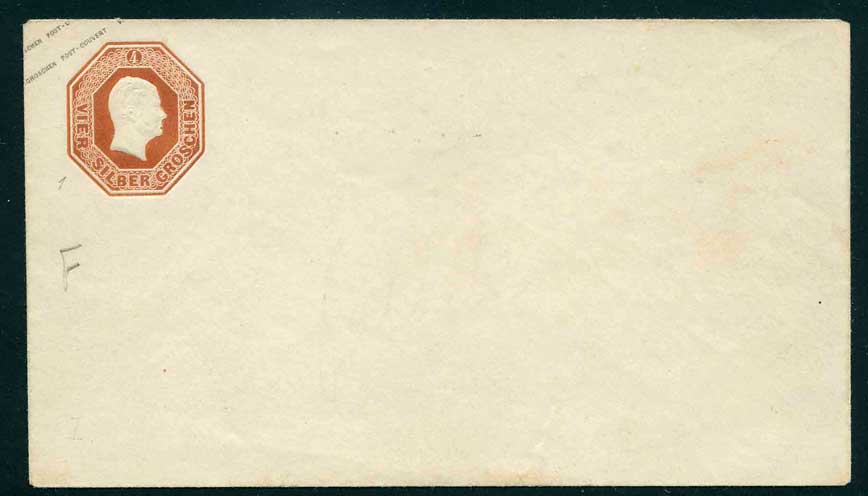 |
|||||
|
|||||
| Preview of Stamps Catalogue: VOLUME 1 |
 |
|||||
|
|||||
| Preview of Stamps Catalogue: VOLUME 1 |
Note: on my website many of the
pictures can not be seen! They are of course present in the catalogue;
contact me if you want to purchase it.
Georges Fouré was a German forger (not to be confused with the much more 'famous' forger Fournier). He lived in the same street as the famous engraver Schilling in Berlin and became friends with him. He then managed to obtain genuine printing plates from Schilling with which he produced 'rarities' of mainly stationary envelopes of several old German States.

The only known portrait of Foure. From Wolfgang Maassen(?)
'Georges Foure - ein Meister seines Faches'
(http://www.bdph.de/kdb/index.php?id=28) . The same image can
also be found in "Le Timbre-Poste' 1887 page XIV and is
reproduced in 'Philatelic Forgers, their Lives ans Works' of
V.E.Tyler.
His life is descirbed in 'Philatelic Forgers their Lives and Works' by V.E.Tyler.
A large number of his products are described in
P. Ohrt's book 'Handbuch der Neudrucke' (in German). For example:
A wrongly embossed 7 k blue 1872 stamp of Germany.

Apparently a Foure forgery of a non-existent 4 sgr envelope of
Prussia. The distinguishing characteristics of this envelope can
be found in Ohrt's reprint book.

A Foure forgery, with forged "DAHLHAUSEN" cancel. This
cancel was bought by Fournier from a old-metal dealer (source
P.Ohrt, Handbuch der Neudrucke, page 598).

Another Foure forged envelope, now with a "GEORG-MARIENHUTTE
10 1" cancel.
Also a book seems to exist on Foure by Reinhard Metz 'Die Geschichte eines genialen Philatelisten und Fälschers' (352 pages).
In the Permanentes Handbuch der Postfreimarkenkunde Erster Teil Deutsche Staaten, Abschnitt XIII: Preussen by Hugo Krötzsch (1896), page 26, we can read that Georges Fouré tried to sell rare misprints 3 sgr black on red of the 1850 Prussia stamps (instead of the usual black on yellow color). He also had pair of these 'misprints' which were only 'discovered' in 1881. Krotzsch quotes the stamp dealer Moens who remarks that the yellow color can easily be removed and replaced by red.
In the Philatelic Record of 1899 (page 2) the
following text can be found:
Dies of old German Stamps. At the annual meeting of German
Collectors in Magdeburg we notice that Dr. Fraenkel made a speech
in reply to certain enquiries, which is full of interest to
Philatelists. Our readers will remember the excitement some years
ago with reference to the overprint of the North German design on
various envelopes of the different States. The excitement
commenced on the publication of Dr. Lindenberg's book dealing
with German envelopes, in which he boldly asserted that most of
the very rare varieties had never existed in a genuine state, and
had, in fact, been manufactured by a Philatelist, who was at that
time not only well known in Berlin, but all over the world. In a
long and interesting speech Dr. Fraenkel informed his hearers
that the Berlin Philatelic Club had now succeeded in obtaining
certain valuable dies, from a gentleman who is the son of an
Official in the Berlin Government Printing Works. It appears that
this young man's father resided for many years in the same house
with the Philatelist (we do not know whether to call him dealer
or collector), who was attacked in Dr. Lindenberg's book, and
after a lapse of some time the following have now been purchased
from him by the Berlin Club, viz :-
1. German Empire, Cliche of the 2 1/2 gr. stamp.
2. Ditto. Reproduction of the Provisional (I) Eagle.
3. North German Confederation, Galvano of the 1 gr. stamp.
4. Ditto. Cliche of the 2gr. stamp.
5. Ditto. Cliche of the square diamond embossing used for the
over-printed envelopes.
6. Prussia, copper cliche of the 3gr. eagle.
7. Ditto, a similar cliche.
8. Ditto. Matrix of the 4pf. eagle.
9. Ditto. Patrix of the same.
10. Cliche of the 10 pf. value (eagle).
11. A similar cliche.
12. Galvano of the 4Sgr. octagon.
13. Wurtemburg, die for an envelope (worn out)
14. A die for impressing the patte of an envelope (with post
rider)
15. Bolivia, Galvano of the 5c, first issue.
16. Persia, Galvano of the 4 Shahi, first issue.
17. Ditto. 8 Shahi.
What strikes us most in the above list is that amongst these
German dies there should have been such things as the Bolivian
and Persian. The dies after being purchased by the Club were
handed over to the Berlin Post Office Museum, so that they can
never again be used for an improper purpose, and we think that
the thanks of all Philatelists are due to Dr. Fraenkel and his
friends for their noble action in the interests of the pursuit.
Literature:
Georges Fouré, Die Geschichte eines genialen Philatelisten und
Fälschers by Reinhard Metz (2009).